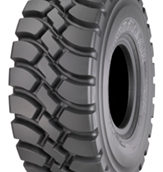When it comes to successful haul truck operation, tires – and what’s underneath those tires – play a critical role. Here are five considerations that will help keep your haul truck tires up and running, courtesy of The Goodyear Tire & Rubber Co.
- Haul truck positioning. When backing a haul truck up to a rock pile, keep a close eye on the positioning of the truck’s rear axle versus the pile’s front edge, and make sure the entire front edge area is clear of debris. “Angle and spacing are crucial,” said Eric Matson, manager, global field engineering, OTR, Goodyear. “Keep the front edge clear, which will help prevent tire cutting, impact damage and other problems. The ground surface should be flat, too. When a newly loaded truck pulls away, the loader should immediately clean the area to remove rocks that might have fallen to the ground during the loading process.”
- Water management. The presence of extra water can result in sub-optimal tire performance. “First, water acts as a lubricant, which makes tires susceptible to cuts,” said Matson. “And standing water at quarry sites can hide ‘tire-eating’ rocks.’” Make sure haul roads are angled correctly, so water drains from them. “Roads should be crowned in the middle to avoid standing water,” he said. “And drainage ditches should be installed along all roads leading into and out of the work site.”
- Spillage maintenance. Spilling a few rocks while loading a haul truck bed is practically unavoidable, according to Matson. “Even the most skilled, experienced load operator can leave some rocks on the ground from time to time,” he said. “But those rocks – no matter how few in number – should be cleared as quickly as possible.” The same can be said when it comes to rocks that have been spilled on roads. “Clear those rocks out of the way as soon as possible, and don’t try to straddle them with your wheels. Most haul trucks have dual tires and it’s only a matter of time before a dual assembly strikes, or rolls over, a sharp rock.”
- Proper road grading. Pay attention to how roads leading into or out of the work site slope upward or downward. Roads that are built too sharply along an upward trajectory can cause the truck’s center of gravity to shift to the back of the vehicle, putting extra strain on its four rear tires. Conversely, roads with a downward slope that’s too steep will shift the truck’s center of gravity forward, placing even more pressure on the vehicle’s two front tires. “Road grades should never exceed 8 percent,” said Matson. “Years ago, while in the field, we once saw a road that was graded at 21 percent with a hard left turn at the bottom. The quarry’s maintenance manager couldn’t figure out why his trucks were having front tire problems!”
- Correct curves. Avoid tight-radius turns on roads. “In fact, curves should be as wide and far-ranging as possible to avoid putting undue pressure on outside tires as trucks drive through them,” noted Matson. Roads should have a “super-elevated profile, similar to what you see at race tracks. This helps give trucks more ‘wiggle room,’ which in turn, can prolong tire life.”
Tires don’t have to contribute to haul truck downtime, according to Matson. “Rather, they should serve as uptime-enhancers, and you can help achieve this by being aware of surface and environmental conditions,” he said.

